Cascaded H-Bridge Converter Based on Current-Source Inverter with DC Links Magnetically Coupled to Reduce the DC Inductors Value
Abstract
:1. Introduction
2. CHB-CSI and the Oscillating Power Issues
2.1. CHB-CSI Converter
2.2. Oscillating Power Issues
- At the load, the 2nd harmonic in the dc current generates a 3rd harmonic in the inverter output current, which can be amplified by the LC equivalent circuit of the output capacitor and the electrical machine inductance.
- At the input, the rectifier injects two current components around fs ± 2fi. These components can be compensated among cells in the input transformer but can also lead to resonance issues in the LC input filter. Additionally, these unwanted components increase the losses of the LC filter and the transformer secondary winding.
3. CHB-CSI with Magnetic Coupling among DC Links in CSI Cells
4. Control Scheme
4.1. About the Control Strategy
4.2. Cell Input Currents Controller
4.3. DC Current Controller
4.4. Cell Reactive Power Controller
4.5. Load Voltage Controller
5. DC Inductor and Magnetic Coupling Design
5.1. DC Inductor Design
5.2. Coupling Transformer Design
5.3. Area Product Relation between Magnetic Devices
5.4. Effect of the DC Inductor Reduction in the Weight, Volume, and Footprint Required in the DC Link
6. Case of Study
6.1. Analysis of the DC Inductor Reduction
6.2. Performance of DC Current Controller
6.3. Performance under Frequency Changes
6.4. Steady-State Performance
7. Experimental Results
8. About the Effect of the Magnetic Coupling-Based DC Inductor Reduction in the Operating Region of the CHB-CSI
8.1. About Ac Components Design
- The LC input filter is designed to attenuate rectifier harmonic currents because of commutation. As in both cases, the DC oscillating power is compensated by the DC inductor for the original topology and the magnetic couplings for the proposed topology; the effect of this power cannot be considered in the design guidelines, which are documented in [29,32]. An additional consideration is to set the resonance frequency out of the band, where the effect of the oscillating power can generate an unwanted harmonic.
- The cell output capacitor is set to achieve a desired THD in the load voltage. This capacitor is designed to filter out the current harmonics injected by the single-phase inverter, considering the current load effect. The design guideline is shown in [15], and [16] examines the above as well as the effect of connecting several cells in series, showing the possibility to reduce the capacitor number when nC increases. In addition, the value of the capacitive filter is minimum when the modulation index of the inverter is maximum.
8.2. Operating Region Effect of the Dc Inductor Reduction
9. Conclusions
Author Contributions
Funding
Institutional Review Board Statement
Informed Consent Statement
Data Availability Statement
Acknowledgments
Conflicts of Interest
Nomenclature
| nC | Number of cells per phase |
| vs | Cell voltage supply |
| ic | Cell input current |
| vT | Topology voltage supply |
| iT | Topology input current |
| vo | Cell output voltage |
| vl | Load voltage |
| iL | Load current |
| sr | Modulating vector (rectifier) |
| si | Modulating signal (inverter) |
| idc | DC link current |
| nC | Number of cells in a series array |
| abc | Stationary coordinates for three-phase input |
| uvw | Stationary coordinates for three-phase output |
| dq | Rotating coordinates |
References
- Rodriguez, J.; Bernet, S.; Bin, W.; Pontt, J.O.; Kouro, S. Multilevel Voltage-Source-Converter Topologies for Industrial Medium-Voltage Drives. IEEE Trans. Ind. Electron. 2007, 54, 2930–2945. [Google Scholar] [CrossRef]
- Franquelo, L.G.; Rodriguez, J.; Leon, J.I.; Kouro, S.; Portillo, R.M.A.M.; Prats, M.A. The age of multilevel converters arrives. IEEE Ind. Electron. Mag. 2008, 2, 28–39. [Google Scholar] [CrossRef] [Green Version]
- Malinowski, M.; Gopakumar, K.; Rodriguez, J.; Pérez, M.A. A Survey on Cascaded Multilevel Inverters. IEEE Trans. Ind. Electron. 2009, 57, 2197–2206. [Google Scholar] [CrossRef]
- Song, Y.; Wang, B. Survey on Reliability of Power Electronic Systems. IEEE Trans. Power Electron. 2013, 28, 591–604. [Google Scholar] [CrossRef]
- Peng, H.; Hagiwara, M.; Akagi, H. Modeling and Analysis of Switching-Ripple Voltage on the DC Link Between a Diode Rectifier and a Modular Multilevel Cascade Inverter (MMCI). IEEE Trans. Power Electron. 2012, 28, 75–84. [Google Scholar] [CrossRef]
- Sun, L.; Zhenxing, W.; Weiming, M.; Xiao, F.; Cai, X.; Zhou, L. Analysis of the DC-Link Capacitor Current of Power Cells in Cascaded H-Bridge Inverters for High-Voltage Drives. IEEE Trans. Power Electron. 2014, 29, 6281–6292. [Google Scholar] [CrossRef]
- Joseph, A.; Chelliah, T.R. A Review of Power Electronic Converters for Variable Speed Pumped Storage Plants: Configurations, Operational Challenges and Future Scopes. IEEE J. Emerg. Sel. Top. Power Electron. 2018, 6, 103–119. [Google Scholar] [CrossRef]
- Wu, B.; Narimani, M. High-Power Converters and AC Drives; John Wiley & Sons, Ltd.: New York, NY, USA, 2017. [Google Scholar]
- Jung, J.J.; Lee, J.H.; Sul, S.K.; Son, G.T.; Chung, Y.H. DC Capacitor Voltage Balancing Control for Delta-Connected Cascaded H-Bridge STATCOM Considering Unbalanced Grid and Load Conditions. IEEE Trans. Power Electron. 2018, 33, 4726–4735. [Google Scholar] [CrossRef]
- Koyama, Y.; Nakazawa, Y.; Mochikawa, H.; Kuzumaki, A.; Sano, K.; Okada, N. A Transformerless 6.6-kV STATCOM based on Hybrid Cascade Multilevel Converter using SiC Devices. IEEE Trans. Power Electron. 2018, 33, 7411–7423. [Google Scholar] [CrossRef]
- Townsend, C.D.; Yu, Y.; Konstantinou, G.; Agelidis, V.G. Cascaded H-Bridge Multilevel PV Topology for Alleviation of Per-Phase Power Imbalances and Reduction of Second Harmonic Voltage Ripple. IEEE Trans. Power Electron. 2015, 31, 5574–5586. [Google Scholar] [CrossRef]
- Shuvo, S.; Hossain, E.; Islam, T.; Akib, A.; Padmanaban, S.; Khan, M.Z.R. Design and Hardware Implementation Considerations of Modified Multilevel Cascaded H-Bridge Inverter for Photovoltaic System. IEEE Access 2019, 7, 16504–16524. [Google Scholar] [CrossRef]
- Coppola, M.; di Napoli, F.; Guerriero, P.; Iannuzzi, D.; Daliento, S.; del Pizzo, A. An FPGA-Based Advanced Control Strategy of a Grid Tied PV CHB Inverter. IEEE Trans. Power Electron. 2015, 31, 806–816. [Google Scholar] [CrossRef]
- Baier, C.R.; Melin, P.E.; Guzman, J.I.; Rivera, M.; Muñoz, J.A.; Rothen, J.; Espinoza, J. Current-source cascaded multilevel converters based on single-phase power cells. In Proceedings of the IECON 2013—39th Annual Conference of the IEEE Industrial Electronics Society, Wien, Austria, 10–13 November 2013; pp. 6207–6212. [Google Scholar]
- Melin, P.; Espinoza, J.; Guzman, J.; Rivera, M.; Espinosa, E.; Rothen, J. Analysis and design of a Cascaded H-Bridge topology based on current-source inverters. In Proceedings of the IECON 2013—39th Annual Conference of the IEEE Industrial Electronics Society, Wien, Austria, 10–13 November 2013; pp. 6189–6194. [Google Scholar]
- Melin, P.E.; Rohten, J.A.; Espinoza, J.R.; Baier, C.R.; Espinosa, E.E.; Munoz, J.A.; Riedemann, J. Analysis and Design of a Multicell Topology Based on Three-Phase/Single-Phase Current-Source Cells. IEEE Trans. Power Electron. 2015, 31, 6122–6133. [Google Scholar] [CrossRef]
- Li, Y.W.; Pande, M.; Zargari, N.R.; Wu, B. An input power factor control strategy for high-power current-source induction motor drive with active front-end. IEEE Trans. Power Electron. 2009, 25, 352–359. [Google Scholar] [CrossRef]
- Zhang, L.; Ruan, X.; Ren, X. Second-Harmonic Current Reduction for Two-Stage Inverter with Boost-Derived Front-End Converter: Control Schemes and Design Considerations. IEEE Trans. Power Electron. 2018, 33, 6361–6378. [Google Scholar] [CrossRef]
- Sun, Y.; Liu, Y.; Su, M.; Xiong, W.; Yang, J. Review of Active Power Decoupling Topologies in Single-Phase Systems. IEEE Trans. Power Electron. 2015, 31, 1. [Google Scholar] [CrossRef]
- Irfan, M.S.; Ahmed, A.; Park, J. Power-Decoupling of a Multiport Isolated Converter for an Electrolytic-Capacitorless Multilevel Inverter. IEEE Trans. Power Electron. 2018, 33, 6656–6671. [Google Scholar] [CrossRef]
- Sun, Y.; Liu, Y.; Su, M.; Li, X.; Yang, J. Active Power Decoupling Method for Single-Phase Current-Source Rectifier with No Additional Active Switches. IEEE Trans. Power Electron. 2016, 31, 5644–5654. [Google Scholar] [CrossRef]
- Melin, P.E.; Baier, C.R.; Espinoza, J.R.; Munoz, J.A.; Ramirez, R.R.; Maurelia, E.A. On the DC inductors size reduction in a multi-cell topology based on current source converters by means of magnetic couplings. In Proceedings of the IECON 2013—39th Annual Conference of the IEEE Industrial Electronics Society, Wien, Austria, 10–13 November 2013; pp. 6275–6280. [Google Scholar]
- Melin, P.E.; Espinoza, J.R.; Baier, C.R.; Rohten, J.A.; Ramirez, R.O.; Moran, L.A. Improved control scheme towards reduced DC link inductors in a Multi-Cell Topology based on Current Source Converters. In Proceedings of the IECON 2012—38th Annual Conference on IEEE Industrial Electronics Society, Montreal, QC, Canada, 25–28 October 2012; pp. 488–493. [Google Scholar]
- Baier, C.R.; Espinoza, J.R.; Melin, P.E.; Espinosa, E.; Munoz, J. A novel multi-level CSI based topology with inter-cell magnetic couplings for minimum DC storage components. In Proceedings of the 2010 IEEE International Symposium on Industrial Electronics, Bari, Italy, 4–7 July 2010; pp. 3193–3198. [Google Scholar]
- Baier, C.R.; Espinoza, J.R.; Rivera, M.; Munoz, J.A.; Bin, W.; Melin, P.E.; Yaramasu, V. Improving Power Quality in Cascade Multilevel Converters Based on Single-Phase Nonregenerative Power Cells. IEEE Trans. Ind. Electron. 2014, 61, 4498–4509. [Google Scholar] [CrossRef]
- Baier, C.R.; Melin, P.E.; Espinoza, J.R.; Munoz, J.; Guzman, J.I. A novel multi-level topology based on current source power cells for high performance applications. In Proceedings of the 2010 IEEE International Conference on Industrial Technology, Vina del Mar, Chile, 14–17 March 2010; pp. 1333–1338. [Google Scholar]
- Espinoza, J.R.; Joos, G.; Moran, L. Decoupled control of the active and reactive power in three-phase PWM rectifiers based on non-linear control strategies. In Proceedings of the 30th Annual IEEE Power Electronics Specialists Conference. Record. (Cat. No.99CH36321), Harleston, SC, USA, 1 July 1999. [Google Scholar]
- Smith, C.A.; Corripio, A.B. Principles and Practice of Automatic Process Control, 2th ed.; Wiley: New York, NY, USA, 2006. [Google Scholar]
- Filsecker, F.; Álvarez, R.; Bernet, S. Design and losses of PWM current source converters. In Proceedings of the 2010 IEEE International Conference on Industrial Technology, Vina del Mar, Chile, 14–17 March 2010; pp. 737–744. [Google Scholar]
- McLyman, C.W.T. Transformer and Inductor Design Handbook, 3rd ed.; CRC Press: Boca Raton, FL, USA, 2004. [Google Scholar]
- Melín, P.E.; Espinoza, J.R.; Rohten, J.A.; Espinosa, E.E.; Baier, C.R.; Guzman, J.I. Cascaded H-Bridge topologies comparison for multi-cell current-source inverters under different DC inductor size reduction methods. In Proceedings of the IECON 2014—40th Annual Conference of the IEEE Industrial Electronics Society, Dallas, TX, USA, 29 October–1 November 2014; pp. 4568–4574. [Google Scholar]
- Zargari, N.R.; Joos, G.; Ziogas, P.D. Input Filter Design for PWM Current-Source Rectifiers. IEEE Trans. Ind. Appl. 1994, 30, 1573. [Google Scholar] [CrossRef]

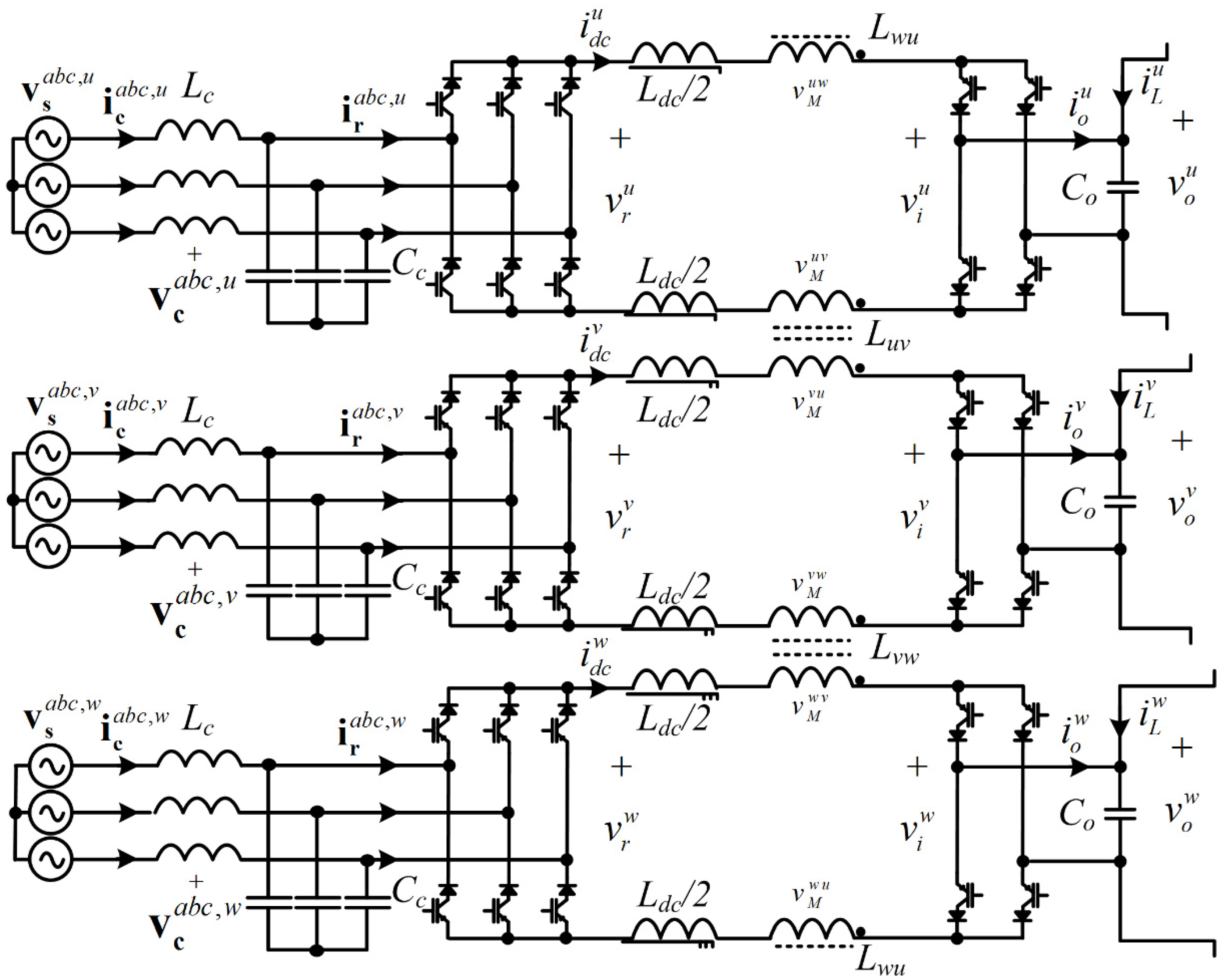
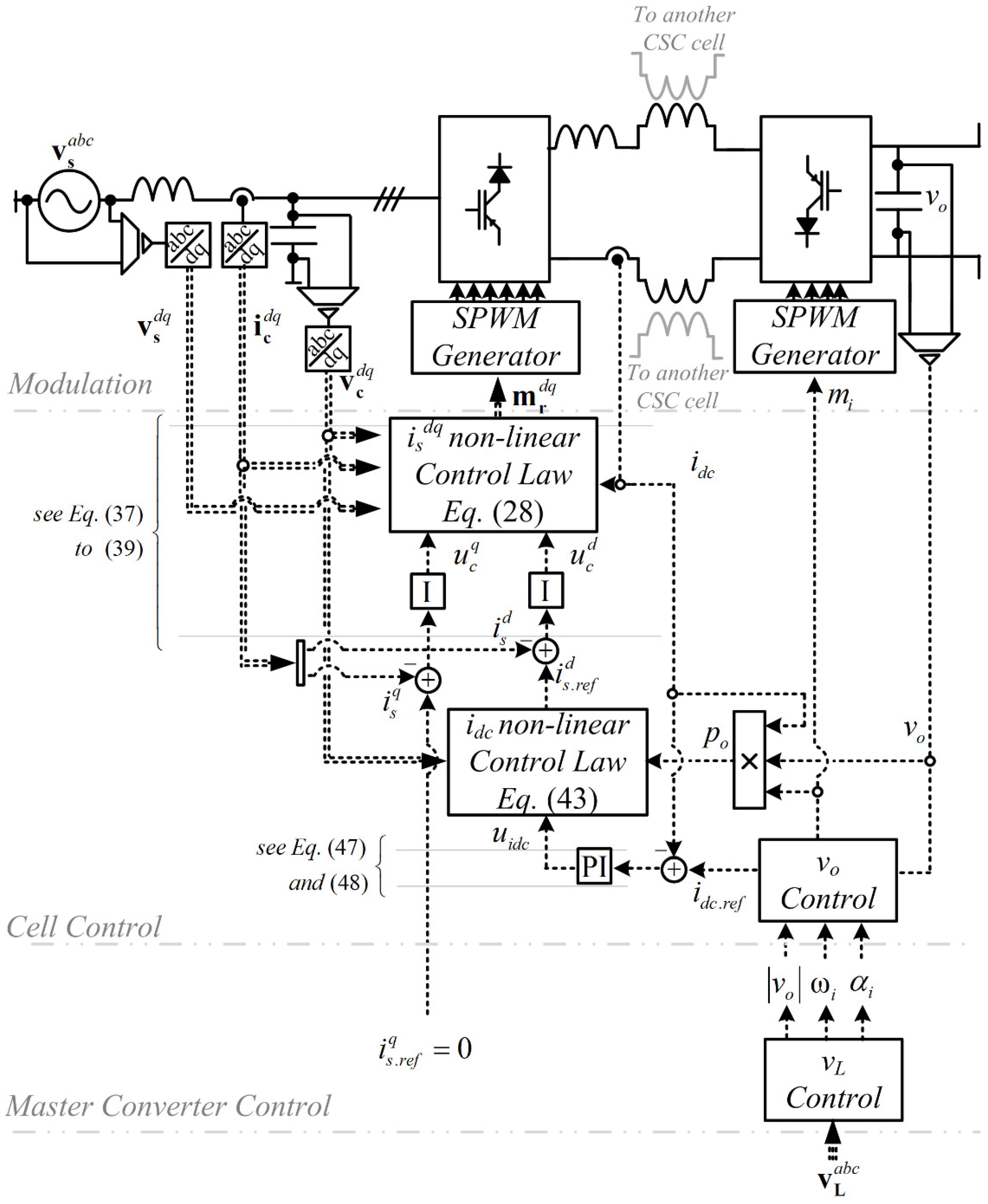
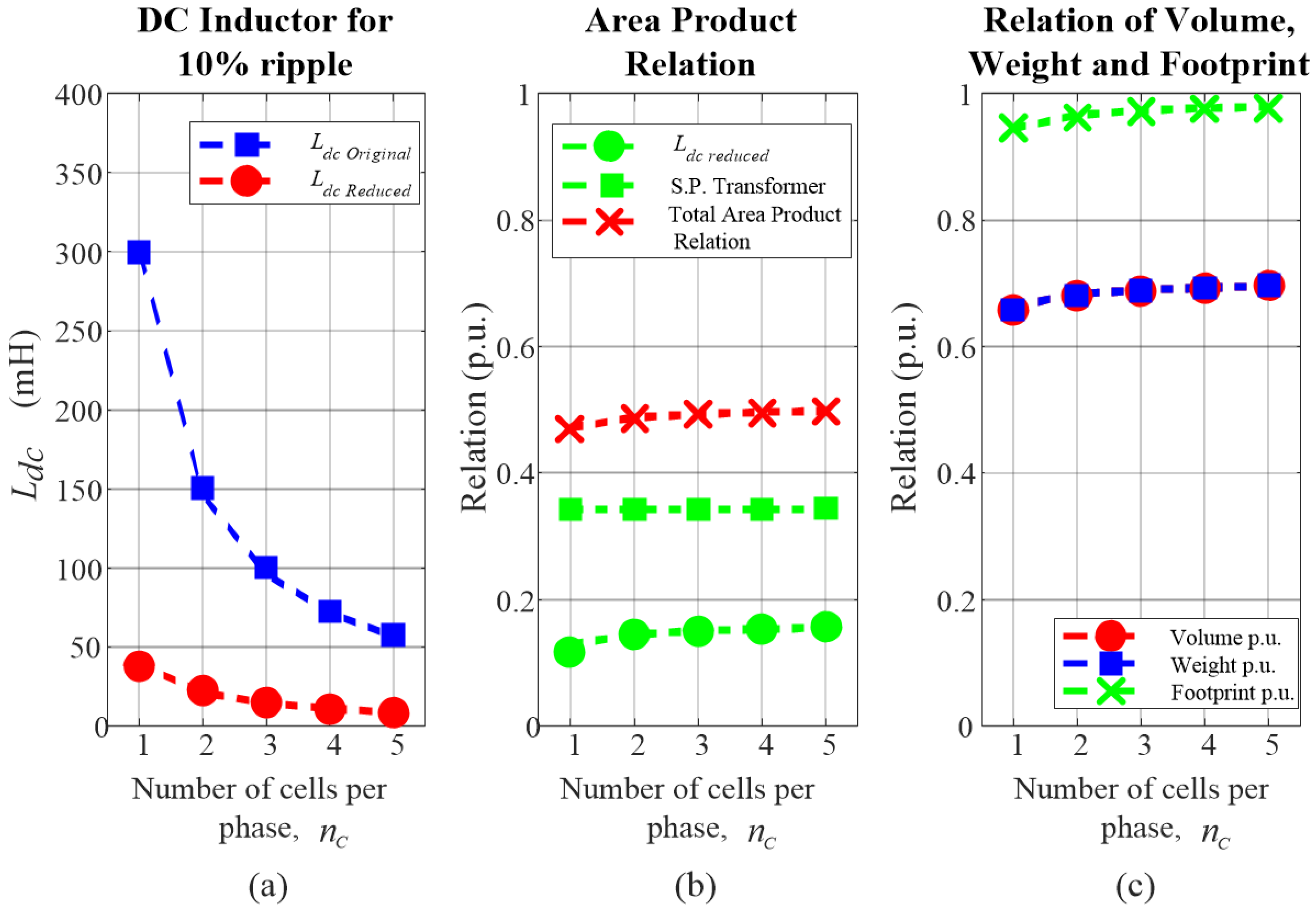
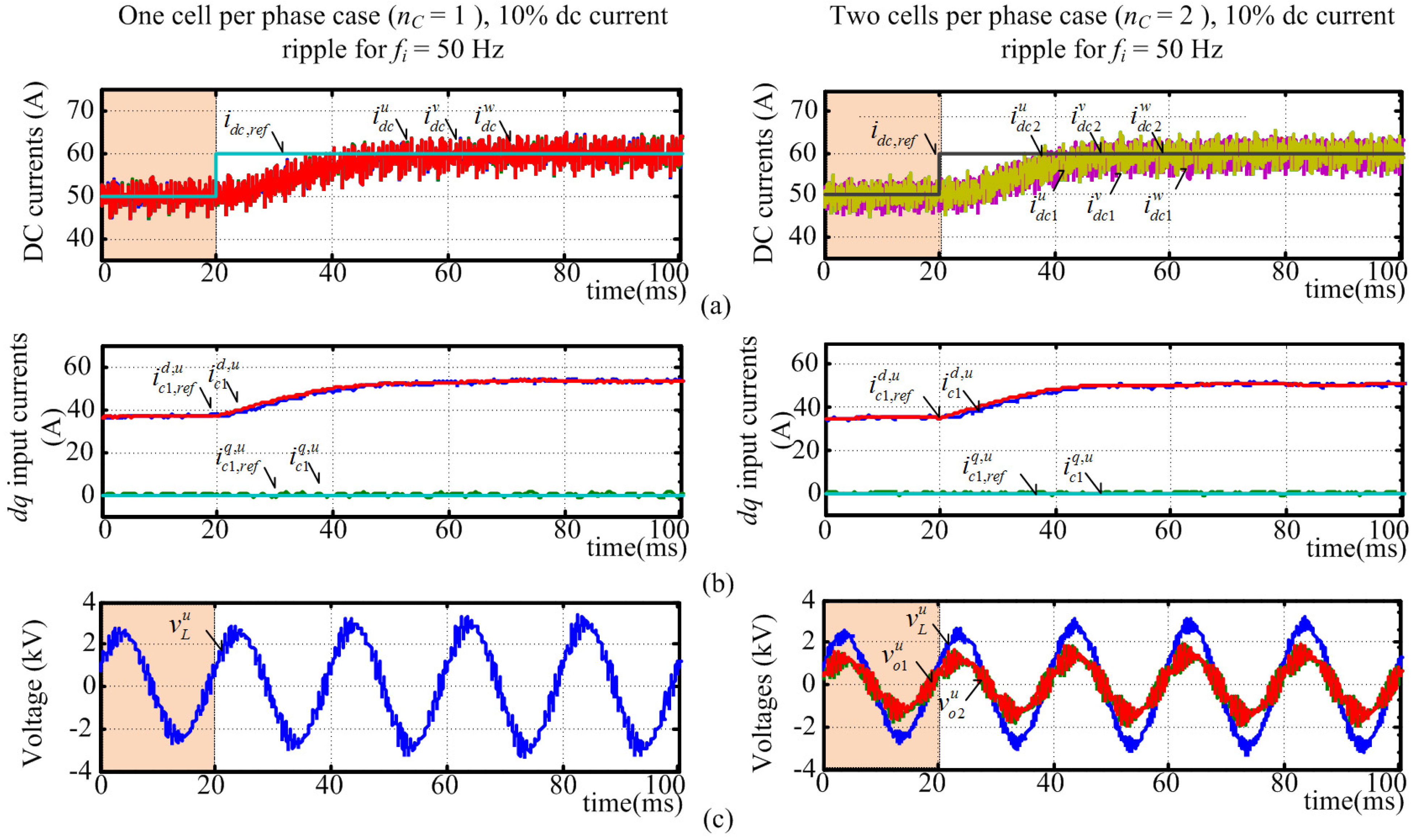




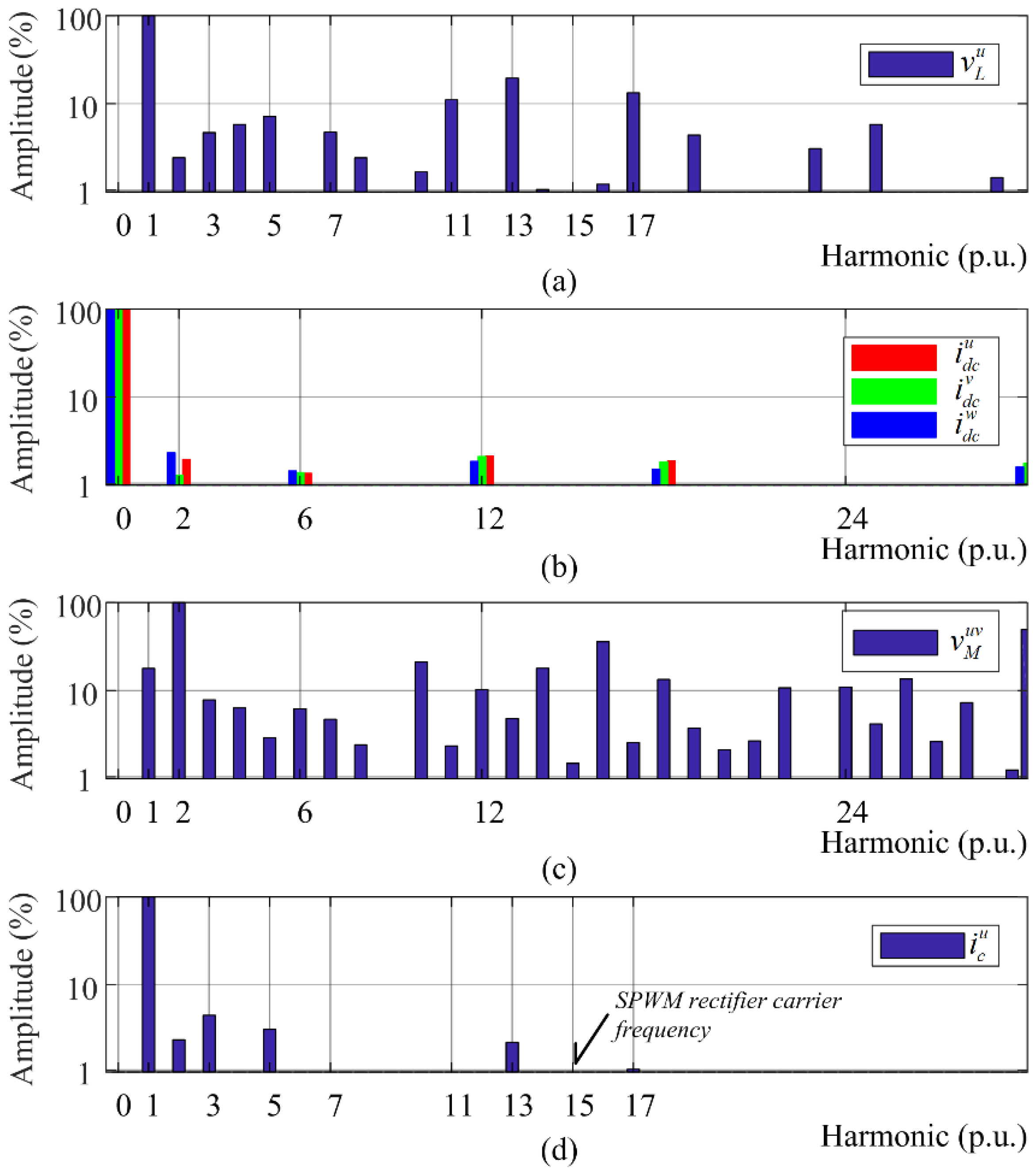
| Magnetic Devices | Area Product Relation | Volume Relation | Weight Relation | Footprint Relation |
|---|---|---|---|---|
| Ldc Original | ||||
| Ldc Reduced | ||||
| DC Link Coupling Transformer |
| Parameter | Simulation Value | Experimental Value | ||
|---|---|---|---|---|
| Load | Rl | 40 | 11 | Ω |
| Ll | 80 | 24 | mH | |
| Cell’s Input Filter | Ls | 12 | 12 | mH |
| Cs | 55 | 40 | µF | |
| DC Inductor for nC = 1 without magnetic coupling | Ldc * | 300 | -- | mH |
| DC Inductor for nC = 1 with magnetic coupling | Ldc | 39 | 36 | mH |
| DC Inductor for nC = 2 with magnetic coupling | Ldc | 21 | -- | mH |
| Output Capacitor | Co | 10 | 20 | µF |
| Rectifier Modulating Frequency | 33 | 15 | p.u. | |
| Inverter Modulating Frequency | 12 | 10 | p.u, | |
| Settling Time Input Current Controller | 7 | 7 | ms | |
| DC Current Control | 251,327 | 251,327 | rad/s | |
| 1 | 1 | |||
Publisher’s Note: MDPI stays neutral with regard to jurisdictional claims in published maps and institutional affiliations. |
© 2022 by the authors. Licensee MDPI, Basel, Switzerland. This article is an open access article distributed under the terms and conditions of the Creative Commons Attribution (CC BY) license (https://creativecommons.org/licenses/by/4.0/).
Share and Cite
Melín, P.E.; Baier, C.R.; Espinosa, E.E.; Espinoza, J.R. Cascaded H-Bridge Converter Based on Current-Source Inverter with DC Links Magnetically Coupled to Reduce the DC Inductors Value. Energies 2022, 15, 324. https://doi.org/10.3390/en15010324
Melín PE, Baier CR, Espinosa EE, Espinoza JR. Cascaded H-Bridge Converter Based on Current-Source Inverter with DC Links Magnetically Coupled to Reduce the DC Inductors Value. Energies. 2022; 15(1):324. https://doi.org/10.3390/en15010324
Chicago/Turabian StyleMelín, Pedro E., Carlos R. Baier, Eduardo E. Espinosa, and José R. Espinoza. 2022. "Cascaded H-Bridge Converter Based on Current-Source Inverter with DC Links Magnetically Coupled to Reduce the DC Inductors Value" Energies 15, no. 1: 324. https://doi.org/10.3390/en15010324









